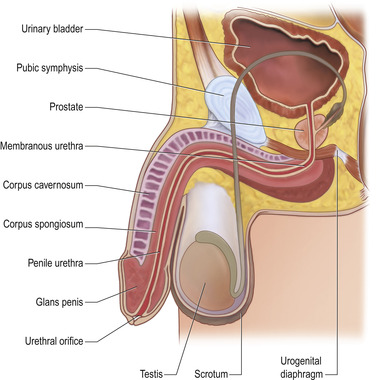CHAPTER 18. URETHRAL CATHETERIZATION
Sushruta, a surgeon of ancient India (circa 6th century BC), described gold, silver, iron and wood tubes lubricated with ghee for the evacuation of urine. Aulus Cornelius Celsus (25 BC–AD 50) described bronze and lead pipes for urethral catheterization in De Re Medicina. Frederick Foley, a medical student in Boston, designed the modern catheter in the 1930s. Fortunately catheters now come in latex, silicone, Teflon and PVC, with some coated in silver alloy to reduce catheter-related infection.
INTRODUCTION
Catheterization is an invasive procedure. It should be carried out in a sensitive manner, maintaining the patient’s dignity at all times. The indication of catheterization determines whether long- or short-term catheters are used and should be considered prior to the procedure.
MALE CATHETERIZATION
INDICATIONS
• Acute urinary retention.
• Haematuria.
• Accurate assessment of urinary output (a measure of organ perfusion) and volume status (e.g. in circulatory shock or acute renal failure).
 Tip Box
Tip BoxA three-way catheter may be required if the indication is urinary retention due to clots (clot-retention). The same technique for catheter insertion as described above applies, with bladder irrigation being delivered via a third catheter lumen.
CONTRAINDICATIONS
• Lack of consent.
• Phimosis/paraphinosis (a relative contraindication).
• Urethral stricture.
• Penile fracture.
EQUIPMENT
• Dressing pack.
• Male catheter.
• Catheter drainage bag.
• Normal saline cleaning solution.
• Gauze.
• Sterile lidocaine anaesthetic gel (e.g. Instillagel®).
• 10 mL sterile water.
• 10 mL syringe.
• Sterile gloves.
• Disposable, loose-fitting outer sterile gloves.
• Kidney bowl.
CATHETER SIZE
Urethral catheters are measured in charrières (ch) after the 19th century French instrument maker Joseph Charrières, representing the outer diameter of the catheter. The size of the catheter in charrières is equivalent to three times its diameter in millimetres (mm): for example, a 12 ch catheter measures 4 mm in diameter. These measurements are commonly referred to as ‘French gauge’. A larger-gauge catheter may be required in circumstances such as haematuria or pyuria, where clots or debris may obstruct urinary flow. In these cases a three-way catheter may be required, with bladder irrigation being delivered via a third catheter lumen to maintain catheter patency. Larger catheters are more likely to cause urethral damage, but too small a catheter can result in leakage around the catheter. Various types are available: Foley, Coude tip (elbow shaped at the tip for negotiating the prostate) and straight. The smallest Foley catheter likely to be effective is normally first choice for general use, usually size 10, 12 or 14 ch in adults.
 Tip Box
Tip BoxIf the catheter will not pass down the urethra (commonly due to an enlarged prostate or urethral stricture), consider using more anaesthetic gel and inserting a larger-sized catheter. Paradoxical though this may seem, a larger catheter will be less flexible in the urethra and hence more likely to negotiate the tighter prostatic urethra. However, never apply substantial force when inserting a catheter; if the catheter does not pass (secondary to a stricture, for example) withdraw the catheter and discuss with a urologist.
PRACTICAL PROCEDURE




